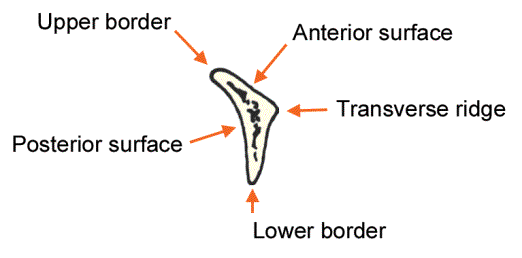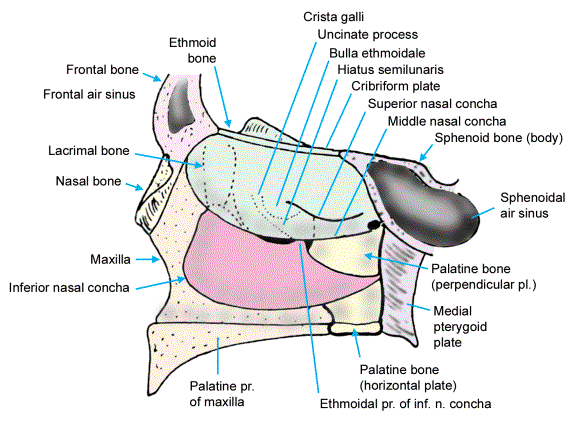 |
| 11 - Brain, purulent inflammation, Haemophilus influenzae meningitis - Gross |
Foci of white-tan purulent exudate are evident over the surface of the brain (acute meningitis).
 |
| 12 - Brain, purulent inflammation, abscess - Gross, coronal cut surface |
The destructive nature of the acute inflammatory reaction in the case of an abscess is apparent here.
 |
| 13 - Larynx and trachea, pseudomembranous inflammation, diphtheria - Gross, cut and mucosal surfaces |
- Epiglottis
- Pseudomembranous exudate in larynx
- Carina
The pseudomembrane is made up of a fibrinopurulent exudate combined with necrotic mucosa. It has a relatively tough consistency and, in this case, has caused suffocation.
 |
| 14 - Colon, pseudomembranous inflammation, colitis caused by clindamycin - Gross, mucosal surface |
Prolonged treatment with antibiotics can destroy the balance of normal intestinal flora, allowing overgrowth of Clostridium difficile. C difficile causes a pseudomembrane similar to that caused by Corynebacterium diphtheriae in the larynx. Notice the rubor (vascular congestion) in the background.
 |
| 15 - Uterine cervix, chronic cervicitis - Very low power (Glass slide 131) |
|
- Columnar mucosa of endocervix
- Area of chronic inflammation
- Cyst
- Squamous mucosa of ectocervix
Use this image for orientation. The chronic inflammation imparts a bluish hue to the stroma, though it is not well visualized at this power. A cyst has formed as a result of obstruction of an endocervical gland.
 |
| 16 - Uterine cervix, chronic cervicitis - Medium power (Glass slide 131) |
A higher power view of the chronic inflammatory infiltrate reveals a lymphoid follicle, an indicator of chronic inflammation.
 |
| 17 - Uterine cervix, chronic cervicitis - High power (Glass slide 131) |
This high-power view demonstrates the mononuclear infiltrate typical of chronic inflammation. A mononuclear infiltrate typically consists of lymphocytes, plasma cells, and macrophages.
 |
| 18 - Gallbladder, chronic cholecystitis and cholelithiasis - Gross, opened |
- Gallstones removed from gallbadder lumen
In this case, cholelithiasis has led to chronic inflammation of the gallbladder with consequent fibrosis of the gallbladder wall, evidenced by thickening and firmness.
 |
| 19 - Liver, chronic inflammation, postnecrotic cirrhosis - Gross, cut surface |
Secondary to a prior episode of severe hepatitis, fibrosis has developed in this liver, altering its architecture.
 |
| 20 - Spleen, granulomatous inflammation, sarcoidosis - Gross, cut surface |
Granulomas are scattered diffusely throughout the splenic parenchyma. Sarcoidosis, a disease of unknown etiology, causes characteristic noncaseating granulomas in many tissues and organs (including the lung, lymph nodes, and spleen).



















































